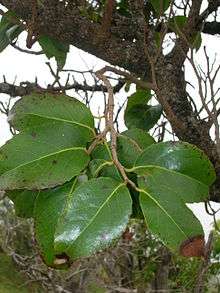Xylosma
Xylosma /zaɪˈlɒzmə/[4] is a genus of flowering plants in the willow family, Salicaceae.[3] It contains around 100 species of evergreen shrubs and trees[5] commonly known as brushhollies, xylosmas, or, more ambiguously, "logwoods". The generic name is derived from the Greek words ξύλον (xylon), meaning "wood," and ὀσμή (osmé), meaning "smell,"[6] referring to the fragrant wood of some of the species.[5] The Takhtajan system places it in the family Flacourtiaceae,[7] which is considered defunct by the Angiosperm Phylogeny Group.[3]
| Xylosma | |
|---|---|
 | |
| Xylosma hawaiiense | |
| Scientific classification | |
| Kingdom: | |
| (unranked): | |
| (unranked): | |
| (unranked): | |
| Order: | |
| Family: | |
| Tribe: | Flacourtieae[1] |
| Genus: | Xylosma |
| Type species | |
| Xylosma orbiculata (J.R.Forst. & G.Forst.) G.Forst.[2] | |
| Species | |
|
About 100, see text | |
| Synonyms | |
Description
The leaves are alternate, simple, entire or finely toothed, 2–10 cm (0.79–3.94 in) long. The flowers are small, yellowish, produced on racemes 1–3 cm (0.39–1.18 in) long, usually dioecious,[8] and have a strong scent. The fruit is a small purple-black berry 5–10 mm (0.20–0.39 in) in diameter that contains 2 to 8 seeds.[5]
Range
The genus is predominantly native to the tropics and subtropics,[5] from the Caribbean, Central America, northern South America, the Pacific Islands, southern Asia and northern Australasia. Two species, X. congestum and X. japonicum, are found in warm-temperate eastern Asia (China, Korea and Japan). Molecular phylogenetic analysis suggest that the genus Lasiochlamys from New Caledonia may be nested in Xylosma.[9]
Ecology
Xylosma foliage is used as food by the caterpillars of some lepidoptera, such as the rustic (Cupha erymanthis), which feeds on X. racemosa, and the common leopard (Phalanta phalantha), which feeds on X. longifolium and X. racemosa.
Uses
The main use for the genus is as hedge and topiary plants among gardeners in desert and chaparral climates. Xylosma congestum is the species usually seen in garden hedges and in road landscaping, despite the fact it bears thorns. Other species cultivated for these purposes include X. bahamensis, X. flexuosa, and X. heterophyllum.[5] X. longifolium is sometimes grown in India for its edible fruits.[10] In addition, a medicinal extract is made from its young leaves that acts as antispasmodic, narcotic, and sedative.[11]
Selected species
|
|
| Wikimedia Commons has media related to Xylosma. |
| Wikispecies has information related to Xylosma |
References
- "Genus Xylosma". Taxonomy. UniProt. Retrieved 2010-01-31.
- "!Xylosma G. Forst". TROPICOS. Missouri Botanical Garden. Retrieved 2010-03-05.
- "Genus: Xylosma G. Forst". Germplasm Resources Information Network. United States Department of Agriculture. 2007-10-05. Retrieved 2010-01-31.
- Brenzel, K. N. (1995). Sunset Western Garden Book (6 ed.). Sunset Publishing Corporation. pp. 606–07. ISBN 978-0-376-03851-7.
- Everett, T. H. (1982). The New York Botanical Garden Illustrated Encyclopedia of Horticulture. 10. Taylor & Francis. p. 3572. ISBN 978-0-8240-7240-7.
- Quattrocchi, U. (2000). CRC World Dictionary of Plant Names: Common Names, Scientific Names, Eponyms, Synonyms, and Etymology. IV R-Z. Taylor & Francis US. p. 2857. ISBN 978-0-8493-2678-3.
- Takhtajan, A. (2009). Flowering Plants (2 ed.). Springer. p. 226. ISBN 978-1-4020-9608-2.
- "Xylosma G. Forster, Fl. Ins. Austr. 72. 1786". Flora of China. eFloras.org. Retrieved 2010-02-03.
- Alford, M.A (2005). Systematics Studies in Flacourtiaceae. PhD Thesis, Cornell University, 2005.
- P. Hanelt, ed. (2001). Mansfeld's Encyclopedia of Agricultural and Horticultural Crops (Except Ornamentals). 3. Springer. p. 1374. ISBN 978-3-540-41017-1.
- Khare, C. P. (2007). Indian Medicinal Plants: An Illustrated Dictionary. Springer. p. 725. ISBN 978-0-387-70637-5.
- "GRIN Species Records of Xylosma". Germplasm Resources Information Network. United States Department of Agriculture. Retrieved 2010-01-31.
- "Xylosma". Integrated Taxonomic Information System. Retrieved 2010-01-31.
- "Subordinate Taxa of !Xylosma G. Forst". TROPICOS. Missouri Botanical Garden. Retrieved 2010-01-31.
- Grandtner, M. M. (2005). Elsevier's Dictionary of Trees. 1. Elsevier. pp. 969–972. ISBN 978-0-444-51784-5.
- Heads, M. (2006). "Seed plants of Fiji: an ecological analysis" (PDF). Biological Journal of the Linnean Society. 89: 459. doi:10.1111/j.1095-8312.2006.00682.x. Retrieved 2010-03-05.